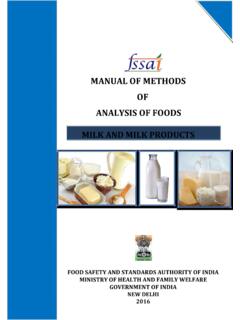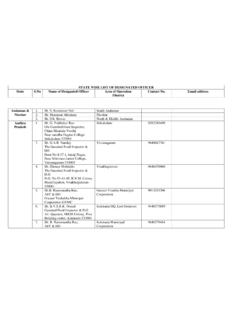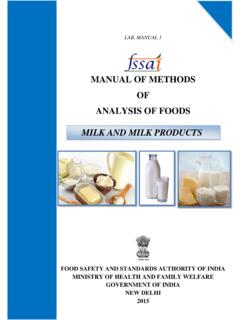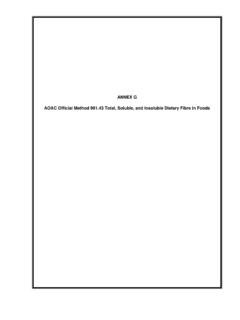Transcription of MANUAL OF METHODS OF ANALYSIS OF FOODS - FSSAI
1 MANUAL OF METHODS OF ANALYSIS OF FOODS FOOD SAFETY AND STANDARDS AUTHORITY OF INDIA MINISTRY OF HEALTH AND FAMILY WELFARE GOVERNMENT OF INDIA NEW DELHI 2016 CEREAL AND CEREAL PRODUCTS CEREALS AND CEREAL PRODUCTS 2016 0 MANUAL FOR ANALYSIS OF CEREAL AND CEREAL PRODUCTS TABLE OF CONTENTS TITLE/METHOD PAGE NO. Food grains 1 1. 1 Definition of Refraction 1 1. 2 Determination of Foreign Matter 2 Determination of Mineral Matter 3 Determination of Refractions other than Foreign Matter 3 Determination of Rodent Excreta and Hair 4 Light Filth in Whole Wheat Flour 5 Determination of Moisture 8 Determination of Uric Acid 9 Test for presence of Ergot in Food grains 10 Determination of Hydrocyanic Acid in Beans 11 Determination of Aflatoxin 12 Determination of Deoxynivalenol (DON) 12 ANALYSIS of Atta (Wheat)
2 13 Determination of Moisture 13 Determination of Total Ash 14 Determination of ash insoluble in dilute HCl 16 Determination of Gluten 17 Determination of Alcoholic Acidity 18 Determination of Calcium Carbonate in Fortified Atta 18 Determination of Total Protein in Protein Rich Atta 19 Determination of Crude Fibre 23 Maida, Fortified Maida, Protein Rich Maida 25 Semolina (Suji) 32 Detection of Kesari Dal Powder(Lathyrus sativus) in Besan 32 Determination of Talc on Rice and Pulses 35 Microscopic Structure of Cereal Starches 36 Biscuits 39 Bread 43 Corn Flour, Corn Flakes and Custard Powder 47 Malted Milk Food 49 Determination of Synthetic Colour in Biscuits, Cakes etc 53 Solvent Extracted Oilseed Flours 55 Determination of Oxalic Acid in Solvent Extracted Sesame Flou 58 Determination of Free and Total Gossypol in Solvent Extracted Cottonseed Flour 61 References 66 Note: The test METHODS given in the manuals are validated/ standardized test METHODS .
3 However, it would be the responsibility of the respective testing laboratory to confirm that the above METHODS are validated in its laboratory and gives proper result in their laboratory. CEREALS AND CEREAL PRODUCTS 2016 1 MANUAL FOR ANALYSIS OF CEREAL AND CEREAL PRODUCTS Standards for cereals, pulses and their products are laid down in Section of Food Safety and Standards (Food Product Standards and Food Additives) Regulations, 2011. These include standards for food grains, their milled products and processed cereal products. In addition standards for malted FOODS and solvent extracted edible oilseed flours are also included under this item.
4 FOOD GRAINS DEFINITION OF REFRACTIONS Refractions mean all components of food grains, which differ from normal grains such as foreign matter, other food grains, damaged grains, weevilled grains, broken, shriveled grains etc. The definition of various refractions is given under Explanation in for items (2-14) in Food Safety and Standards (Food Product Standards and Food Additives) Regulations, 2011. Additional definitions are: (1) Karnal bunt Grains of wheat having a dull appearance and blackish in colour, the blackness spreading along the longitudinal furrow on the ventral side giving the kernels a boat like appearance. The grains are affected by a field fungus Neovossia indica.
5 (2) Ergot Grains of wheat showing a slightly curved body in the ear in place of kernel. Ergot is produced by fungus Claviceps pupurea. Ergot produces Ergotoxin and occurs in rye, millets and wheat (Ref: - IS: 8184 1976 Method for determination of Ergot in Food grains). (3) Filth Any objectionable matter contributed by animal contamination of the product such as rodent, insect or bird matter, or any other objectionable matter contributed by insanitary conditions (a) Heavy Filth Heavier filth material separated from product by sedimentation based on different densities of filth, food particles and immersion liquids such as Chloroform etc.
6 Examples of such filth are insect and rodent excreta pellets and pellet fragments, sand and soil. (b) Light filth Lighter filth particles that are oleophilic and are separated from product by floating them in an oil aqueous liquid mixture. Examples are insect fragments, whole insects, rodent hairs and feather barbules. (c) Sieved filth Filth particles of specific size ranges separated quantitatively CEREALS AND CEREAL PRODUCTS 2016 2 from product by use of selected sieve mesh sizes. (Ref: - aoac 17th edn, 2000, official method 970. 66 Light and Heavy Filth) Equipment (a) Balance sensitivity 1 mg (b) I. S sieves of round holes having following aperture size: Top mm Second from top mm Third from top mm Fourth from top mm A solid bottom pan at the bottom (c) Enameled Trays Flat type 30 cm diameter with raised rims (d) Small scoop (e) Forceps (f) Magnifying glass with a handle of about cm and a magnification of 10.
7 Procedure Examine the test sample for its general condition, such as appearance: freedom from moulds, insect infestation, off odour, poisonous and deleterious matter. DETERMINATION OF FOREIGN MATTER Determine foreign matter by transferring 500 gm of the sample over the set of sieves arranged in such a way that the sieve with the largest perforation comes at the top and those with smaller perforations are placed in the descending order of their sizes and the solid pan at the bottom. Agitate the sample thoroughly to strain out the foreign matter at various levels. As a result of this straining, other food grains and foreign matter like bold pieces of clay, chaff etc shall remain on the first three sieves according to their sizes.
8 The top most sieve would contain bold grains, big pieces of clay and other big sized foreign matter, while the lower sieves would contain smaller, shriveled and CEREALS AND CEREAL PRODUCTS 2016 3 badly insect damaged grains and smaller foreign matter. Separate the sieves after straining and pick up all foreign matter and add it to the foreign matter collected on the bottom pan. Weigh the total foreign matter of the bottom pan and calculate the percentage. In the case of rice, millets and smaller sized grains the quantity of sample for test should be 250 gm. For the purpose of reducing the quantity of test sample, spread the entire sample in a tray, divide it into four equal portions, collect two opposite quarters and repeat this process till the required quantity of sample is collected.
9 DETERMINATION OF MINERAL MATTER Separate the foreign matter into mineral (inorganic) and organic foreign matter by transferring the entire foreign matter collected into a beaker containing carbon tetrachloride. The inorganic extraneous matter (mineral matter) will settle down, which can be separated from organic foreign matter. Remove the organic foreign matter, dry at 100 C and weigh. Calculate the percentage. The remaining amount shall be the mineral matter. DETERMINATION OF REFRACTIONS OTHER THAN FOREIGN MATTER Mix the contents of the four sieves freed from foreign matter together and spread out evenly on a flat smooth surface. From this spread take exactly the specified quantity required for ANALYSIS as indicated below from different parts by quartering the sample.
10 Place the weighed quantity in an enameled tray. Then pick out by hand with the help of magnifying glass, if necessary, various refractions as per the definitions given under (2-14) of Food Safety and Standards (Food Products Standards and Food Additives) Regulations, 2011. Weigh each refraction and calculate the percentage. Quantity of sample to be taken for determining refractions other than foreign matter Bolder grains such as: Wheat/Maize/Barley/Whole pulses: 50 gm Smaller grains such as: Rice/Split pulses/millets: 20gm (Ref: IS 4333 (Part 1): 1996 METHODS of ANALYSIS for Food grains Part I Refractions) CEREALS AND CEREAL PRODUCTS 2016 4 DETERMINATION OF RODENT EXCRETA AND HAIR Rodent Excreta Weigh 50 gm of sample in a 250 mL hooked-lipped beaker.










